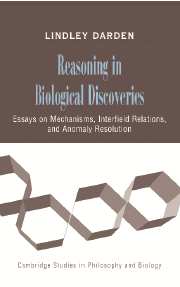 Reasoning in Biological Discoveries
Reasoning in Biological Discoveries Book contents
- Frontmatter
- Contents
- Long Contents
- List of Figures
- List of Tables
- Acknowledgments
- Introduction
- PART I BIOLOGICAL MECHANISMS
- PART II REASONING STRATEGIES: RELATING FIELDS, RESOLVING ANOMALIES
- 5 Interfield Theories with Nancy Maull
- 6 Theory Construction in Genetics
- 7 Relations Among Fields in the Evolutionary Synthesis
- 8 Selection Type Theories with Joseph A. Cain
- 9 Strategies for Anomaly Resolution: Diagnosis and Redesign
- 10 Exemplars, Abstractions, and Anomalies: Representations and Theory Change in Mendelian and Molecular Genetics
- 11 Strategies for Anomaly Resolution in the Case of Adaptive Mutation
- PART III DISCOVERING MECHANISMS: CONSTRUCTION, EVALUATION, REVISION
- Bibliography
- Index
- References
10 - Exemplars, Abstractions, and Anomalies: Representations and Theory Change in Mendelian and Molecular Genetics
Published online by Cambridge University Press: 31 August 2009
- Frontmatter
- Contents
- Long Contents
- List of Figures
- List of Tables
- Acknowledgments
- Introduction
- PART I BIOLOGICAL MECHANISMS
- PART II REASONING STRATEGIES: RELATING FIELDS, RESOLVING ANOMALIES
- 5 Interfield Theories with Nancy Maull
- 6 Theory Construction in Genetics
- 7 Relations Among Fields in the Evolutionary Synthesis
- 8 Selection Type Theories with Joseph A. Cain
- 9 Strategies for Anomaly Resolution: Diagnosis and Redesign
- 10 Exemplars, Abstractions, and Anomalies: Representations and Theory Change in Mendelian and Molecular Genetics
- 11 Strategies for Anomaly Resolution in the Case of Adaptive Mutation
- PART III DISCOVERING MECHANISMS: CONSTRUCTION, EVALUATION, REVISION
- Bibliography
- Index
- References
Summary
INTRODUCTION
This chapter discusses representation of scientific theories and reasoning in theory change. A scientific theory may be represented by a set of concrete exemplary problem solutions. Or, alternatively, a theory may be depicted in an abstract pattern, which when its variables are filled with constants becomes a particular explanation. The exemplars and abstractions may be depicted diagrammatically, as they are in the cases from Mendelian and molecular genetics to be discussed. One way that a theory grows is by adding new types of exemplars to its explanatory repertoire. Model anomalies show the need for a new exemplar; they turn out to be examples of a typical, normal pattern that had not been included in the previous stage of theory development. A special-case anomaly indicates the need for a new exemplar or abstraction, but it has a small scope of applicability. Thus, our subjects here are exemplars, abstractions, diagrammatic representations, and anomalies and the roles they play in the representation of explanatory theories and in the change of such theories. Examples will be taken from Mendelian and molecular genetics.
EXEMPLARS, ABSTRACTIONS, AND DIAGRAMS
Thomas Kuhn (1970, 1974) discussed the importance of “exemplars,” which he characterized as concrete problem solutions in which a formalism is applied and given empirical grounding. Kuhn said that exemplars are taught by the use of problems in textbooks.
- Type
- Chapter
- Information
- Reasoning in Biological DiscoveriesEssays on Mechanisms, Interfield Relations, and Anomaly Resolution, pp. 229 - 247Publisher: Cambridge University PressPrint publication year: 2006
